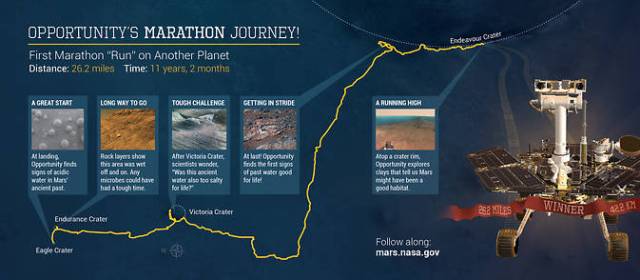Mar 26 2015
There was no tape draped across a finish line, but NASA is celebrating a win. The agency’s Mars Exploration Rover Opportunity completed its first Red Planet marathon Tuesday -- 26.219 miles (42.195 kilometers) – with a finish time of roughly 11 years and two months.
 This illustration depicts some highlights along the route as NASA's Mars Exploration Rover Opportunity drove as far as a marathon race during the first 11 years and two months after its January 2004 landing in Eagle Crater. Image Credit: NASA/JPL-Caltech/Cornell Univ./USGS/Arizona State Univ.
This illustration depicts some highlights along the route as NASA's Mars Exploration Rover Opportunity drove as far as a marathon race during the first 11 years and two months after its January 2004 landing in Eagle Crater. Image Credit: NASA/JPL-Caltech/Cornell Univ./USGS/Arizona State Univ.
"This is the first time any human enterprise has exceeded the distance of a marathon on the surface of another world," said John Callas, Opportunity project manager at NASA's Jet Propulsion Laboratory (JPL) in Pasadena, California. "A first time happens only once."
The rover team at JPL plans a marathon-length relay run at the laboratory next week to celebrate.
The long-lived rover surpassed the marathon mark during a drive of 153 feet (46.5 meters). Last year, Opportunity became the long-distance champion of all off-Earth vehicles when it topped the previous record set by the former Soviet Union's Lunokhod 2 moon rover.
"This mission isn't about setting distance records, of course; it's about making scientific discoveries on Mars and inspiring future explorers to achieve even more," said Steve Squyres, Opportunity principal investigator at Cornell University in Ithaca, New York. "Still, running a marathon on Mars feels pretty cool."
Opportunity's original three-month prime mission in 2004 yielded evidence of environments with liquid water soaking the ground and flowing on planet’s surface. As the rover continued to operate far beyond expectations for its lifespan, scientists chose the rim of Endeavour Crater as a long-term destination. Since 2011, examinations of Endeavour's rim have provided information about ancient wet conditions less acidic, and more favorable for microbial life, than the environment that left clues found earlier in the mission.
JPL manages the Mars rover projects for NASA's Science Mission Directorate in Washington. The Mars Exploration Rover Project, NASA's newer Curiosity Mars rover, and three active NASA Mars orbiters are part of NASA's Mars Exploration Program, which seeks to characterize and understand Mars as a dynamic system, including its present and past environment, climate cycles, geology and biological potential. In parallel, NASA is developing the human spaceflight capabilities needed for its journey to Mars.
For more information about Opportunity, visit /rovers
Follow the project on social media at: https://twitter.com/MarsRovers and https://www.facebook.com/mars.rovers